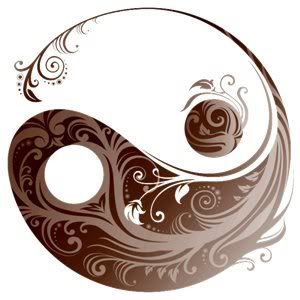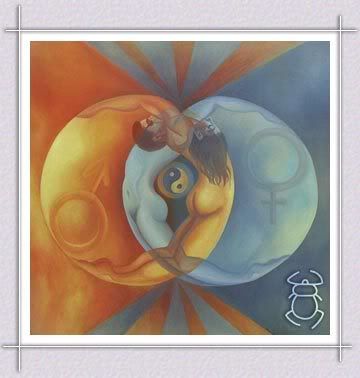Yin Yang (in the West it's referred to as Yin and Yang) defined:
 Yin-Yang. Yin corresponds to darkness, coldness, dampness and Earth; yang to light, warmth, dryness and Heaven. They are in constant conflict, but neither force can ever completely vanquish the other.
Yin-Yang. Yin corresponds to darkness, coldness, dampness and Earth; yang to light, warmth, dryness and Heaven. They are in constant conflict, but neither force can ever completely vanquish the other.The two opposite energies in Chinese thought, from whose interaction and fluctuation the universe and its diverse forms emerge. They are the polar extremes of the unbounded Tao of the supreme and ultimate source (t'ai-chi) and from their intermingling arise the five elements (wu-hsing), which give rise to the myriad of forms, and to history and time. The yin-yang symbol expresses this interaction, the with the two spots (white in the dark, dark in the white) indicating that each of the two contains the seed of the other and is about to produce the replication of its opposite in interaction. All oppositions can be mapped onto yin and yang, yin representing e.g. the feminine, yielding, receptive, moon, water, clouds, even numbers, and the yang the masculine, hard, active, red, the sun, and odd numbers.
Two principles in Chinese philosophy and religion: yin represents a dark, negative, feminine figure, and yang symbolizes a positive, light, masculine figure. Together they are believed to influence the destinies of other people and things. Also, some refer to the dark segment as the autumnal equinox, the light section as the vernal equinox, the dark dot as the summer solstice, and the light dot as the winter solstice, thus representing the entire celestial phenomenon of seasons and the cycle of the sun.
I'm thinkin about getting a Yin Yang tattoo... anyone like any of the above? Have any ideas?












1 comment:
Hi, great artwork and brilliant picture of the two models in a white and black dress!
To the Yin and Yang; they are not really on conflict just as the day and night are not in conflict. The original descriptions goes;
"The ever opposing and Complimenting forces". Originally they were represented by the Dragon and Phoenix symbols and were called Liang-i or Liang-Yi.
Sijo Robert Z
Shaolin Kung Fu Academy
Post a Comment